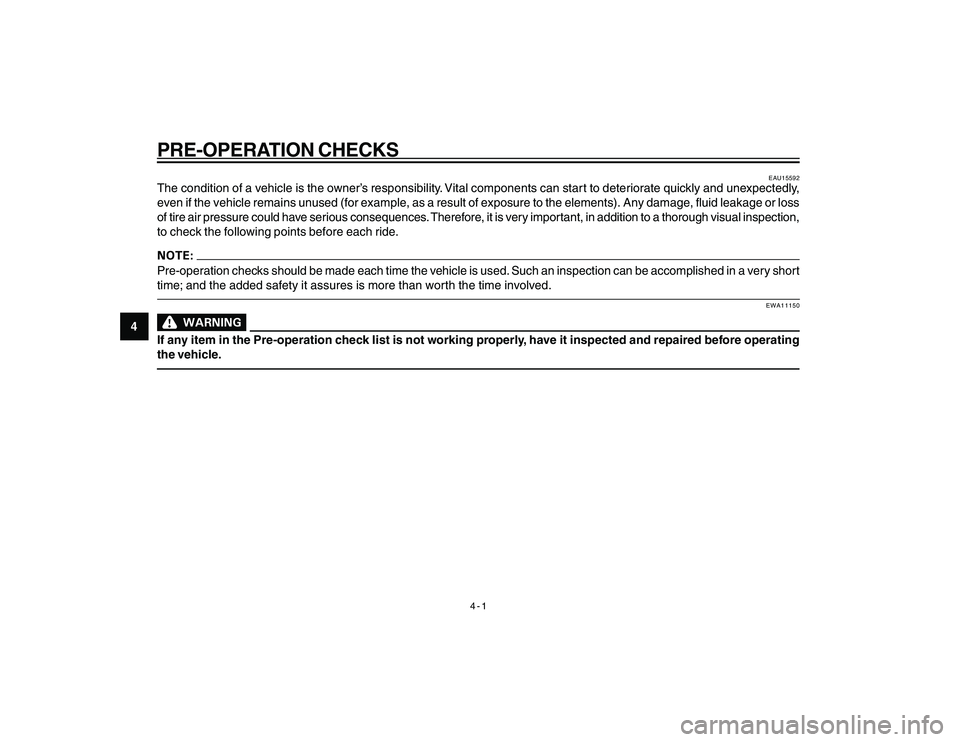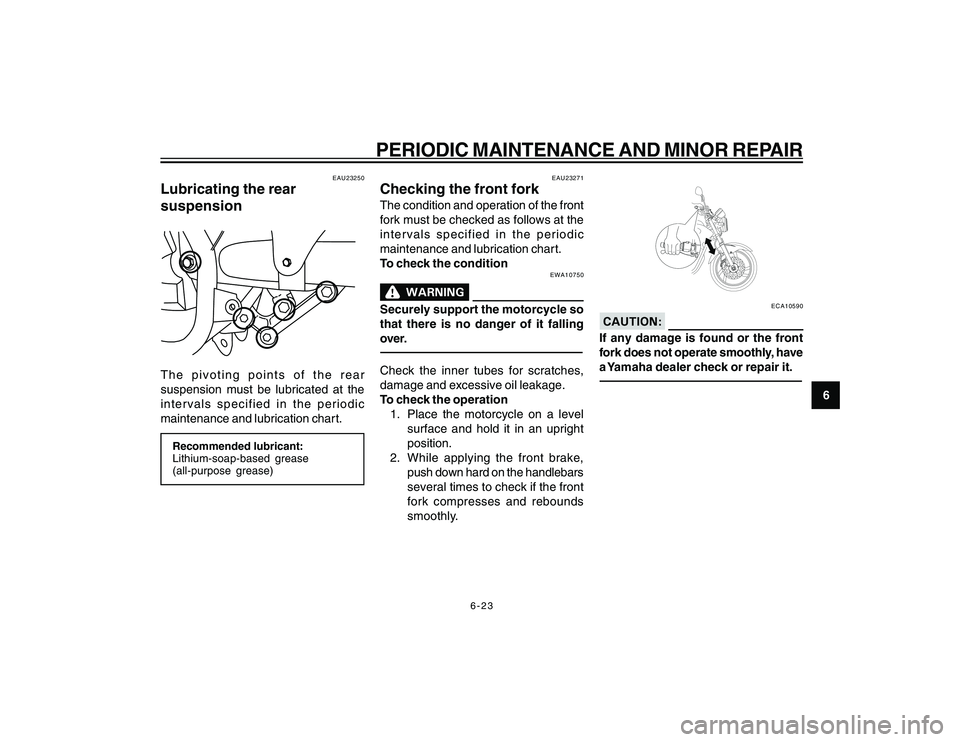2007 YAMAHA YBR250 air condition
[x] Cancel search: air conditionPage 27 of 74

4-1
4
PRE-OPERATION CHECKS
EAU15592
The condition of a vehicle is the owner’s responsibility. Vital components can start to deteriorate quickly and unexpectedly,
even if the vehicle remains unused (for example, as a result of exposur\
e to the elements). Any damage, fluid leakage or loss
of tire air pressure could have serious consequences. Therefore, it is very important, in addition to a thorough visual inspection,
to check the following points before each ride.Pre-operation checks should be made each time the vehicle is used. Such an inspection can be accomplished in a very short
time; and the added safety it assures is more than worth the time involved.
EWA11150
If any item in the Pre-operation check list is not working properly, have it inspected and repaired before operating
the vehicle.
cap 4.pmd 24/1/2007, 14:37
1
Page 34 of 74

6-1
6
PERIODIC MAINTENANCE AND MINOR REPAIR
EAU17240
Safety is an obligation of the owner.
Periodic inspection, adjustment and
lubrication will keep your vehicle in the
safest and most efficient condition
possible. The most important points of
inspection, adjustment, and lubrication
are explained on the following pages.
The intervals given in the periodic
maintenance and lubrication chart
should be simply considered as a
general guide under normal riding
conditions. However, DEPENDING ON
THE WEATHER, TERRAIN,
GEOGRAPHICAL LOCATION, AND
INDIVIDUAL USE, THE
MAINTENANCE INTERVALS MAY
NEED TO BE SHORTENED.
EWA10320
If you are not familiar with
maintenance work, have a Yamaha
dealer do it for you.
EAU17390
Owner’s tool kit1. Owner’s tool kit
2. BandThe owner’s tool kit is located under the
seat. (See page 3-9.)
The service information included in this
manual and the tools provided in the
owner’s tool kit are intended to assist
you in the performance of preventive
maintenance and minor repairs.
However, additional tools such as a
torque wrench may be necessary to
perform certain maintenance work
correctly.If you do not have the tools or experience
required for a particular job, have a
Yamaha dealer perform it for you.
EWA10350
Modifications not approved by
Yamaha may cause loss of
performance and render the vehicle
unsafe for use. Consult a Yamaha
dealer before attempting any changes.
cap 6.pmd24/1/2007, 14:37
1
Page 40 of 74

6-7
6
PERIODIC MAINTENANCE AND MINOR REPAIR
1. Remove the seat. (See page 3-9.)
2. Remove the screws, and then pullthe panel to the outside as shown.To install the panel1. Place the panel in the original position, and install the screws.
2. Install the seat.
EAU19630
Checking the spark plugl
The spark plug is an important
engine component, which is easy
to check. Since heat and deposits
will cause any spark plug to slowly
erode, the spark plug should be
removed and checked in
accordance with the periodic
maintenance and lubrication chart.
In addition, the condition of the
spark plug can reveal the condition
of the engine.
To remove the spark plug 1. Remove cowling. (See page 6-6.)
1. Spark plug cap2. Remove the spark plug cap.
3. Remove the spark plug as shown, with the spark plug wrench included
in the owner’s tool kit.
1. Spark plug wrenchTo check the spark plug1. Check that the porcelain insulator around the center electrode of the
spark plug is a medium-to-light tan
(the ideal color when the
motorcycle is ridden normally).If the spark plug shows a distinctly
different color, the engine could be
defective. Do not attempt to diagnose
such problems yourself. Instead, have
a Yamaha dealer check the motorcycle.2. Check the spark plug for electrodeerosion and excessive carbon or
other deposits, and replace it if
necessary.
cap 6.pmd 24/1/2007, 14:37
7
Page 46 of 74

6-13
6
PERIODIC MAINTENANCE AND MINOR REPAIR
EAU21560
TiresTo maximize the performance, durability,
and safe operation of your motorcycle,
note the following points regarding the
specified tires.
Tire air pressure
The tire air pressure should be checked
and, if necessary, adjusted before each
ride.
EWA10500
l
l l
l
l
The tire air pressure must be
checked and adjusted on cold
tires (i.e., when the temperature
of the tires equals the ambient
temperature).
l
l l
l
l
The tire air pressure must be
adjusted in accordance with the
riding speed and with the total
weight of rider, passenger, cargo,
and accessories approved for
this model.
Tire air pressure (measured
on cold tires):0 - 90 kg (0 - 198 lb):
Front:
225 kPa (33 psi) (2.25 kgf/cm²)
Rear:
250kPa (36 psi) (2.50 kgf/cm²)
Loading condition:
90 - 167 kg (198 - 368 lb)
Front:
225 kPa (33 psi) (2.25 kgf/cm²)
Rear:
250 kPa (36 psi) (2.50 kgf/cm²)
Maximum load*:
167 kg (368 lb)
* Total weight of rider, passenger, cargo and accessories
EWA11020
Because loading has an enormous
impact on the handling, braking,
performance and safety
characteristics of your motorcycle,
you should keep the following
precautions in mind.l
l l
l
l
NEVER OVERLOAD THE
MOTORCYCLE! Operation of an
overloaded motorcycle may
result in tire damage, loss of control, or severe injury. Make
sure that the total weight of rider,
passenger, cargo, and
accessories does not exceed the
specified maximum load for the
vehicle.
l
l l
l
l
Do not carry along loosely
packed items, which can shift
during a ride.
l
l l
l
l
Securely pack the heaviest items
close to the center of the
motorcycle and distribute the
weight evenly on both sides.
l
l l
l
l
Adjust the suspension and tire
air pressure with regard to the
load.
l
l l
l
l
Check the tire condition and air
pressure before each ride.
cap 6.pmd 24/1/2007, 14:37
13
Page 54 of 74

6-21
6
PERIODIC MAINTENANCE AND MINOR REPAIR
EAU23100
Checking and lubricating the
cablesThe operation of all control cables and
the condition of the cables should be
checked before each ride, and the
cables and cable ends should be
lubricated if necessary. If a cable is
damaged or does not move smoothly,
have a Yamaha dealer check or replace
it.Recommended lubricant:Engine oil
EWA10720
Damage to the outer sheath may
interfere with proper cable operation
and will cause the inner cable to rust.
Replace a damaged cable as soon as
possible to prevent unsafe
conditions.
EAU23111
Checking and lubricating the
throttle grip and cableThe operation of the throttle grip should
be checked before each ride. In addition,
the cable should be lubricated at the
intervals specified in the periodic
maintenance chart.
EAU23140
Checking and lubricating the
brake and clutch levers
1
2
1. Brake lever
2. Lubrication point1. Clutch lever
2. Lubrication pointThe operation of the brake and clutch
levers should be checked before each
ride, and the lever pivots should be
lubricated if necessary.
cap 6.pmd 18/4/2007, 14:35
21
Page 56 of 74

6-23
6
PERIODIC MAINTENANCE AND MINOR REPAIR
EAU23250
Lubricating the rear
suspensionThe pivoting points of the rear
suspension must be lubricated at the
intervals specified in the periodic
maintenance and lubrication chart.Recommended lubricant:
Lithium-soap-based grease
(all-purpose grease)
EAU23271
Checking the front forkThe condition and operation of the front
fork must be checked as follows at the
intervals specified in the periodic
maintenance and lubrication chart.
To check the condition
EWA10750
Securely support the motorcycle so
that there is no danger of it falling
over.Check the inner tubes for scratches,
damage and excessive oil leakage.
To check the operation1. Place the motorcycle on a level surface and hold it in an upright
position.
2. While applying the front brake, push down hard on the handlebars
several times to check if the front
fork compresses and rebounds
smoothly.
ECA10590
If any damage is found or the front
fork does not operate smoothly, have
a Yamaha dealer check or repair it.
cap 6.pmd 24/1/2007, 14:38
23
Page 71 of 74

8-2
SPECIFICATIONS
8
28/22 (1.273)
4th:
26/25 (1.040)
5th:
23/27 (0.852)
Chassis:Frame type:Double cradle
Caster angle: 26.50 º
Trail:
104.5 mm (4.11 in)Front tire:Type:Tubeless
Size:
100/80-17M/C (52S)
Manufacturer/model: PIRELLI/SPORT DEMONRear tire:Type:Tubeless
Size:
130/70-17M/C (62S)
Manufacturer/model:
PIRELLI/SPORT DEMONLoading:Maximum load:167 kg (368 b)
(Total weight of rider, passenger, cargo
and accessories)
Tire air pressure (measured on cold
tires):Loading condition:0-90 kg (0-198 lb)
Front:
225 kPa (33 psi) (2.25 kgf/cm
2)
Rear: 250 kPa (36 psi) (2.50 kgf/cm2)
Loading condition:
90-167 kg (198-368 lb)
Front:
225 kPa (33 psi) (2.25 kgf/cm2)
Rear: 250 kPa (36 psi) (2.50 kgf/cm2)
Front wheel:Wheel type:Cast wheel
Rim size:
17M/C x MT2.15Rear wheel:Wheel type:Cast wheel
Rim size:
17M/C x MT3.00Front brake:Type:Single disc brake
Operation: Right hand operation
Recommended fluid:
DOT 3 or 4
Rear brake:Type: Leading, trailing drum brake
Operation: Right foot operation
Recommended fluid:
DOT 3 or 4Front suspension:Type:Telescopic fork
Spring/shock absorber type:
Coil spring/oil damper
Wheel travel: 120.0 mm (4.72 in)Rear suspension:Type:Swingarm (link suspension)
Spring/shock absorber type:
Coil spring/oil damper
Wheel travel:
120.0 mm (4.72 in)Electrical system:Ignition system: Transistorized coil ignition (digital)
Charging system: AC magnetoBattery:Model: YTX77L-BS
Voltage, capacity:
12 V, 6.0 Ah
cap 8.pmd 24/1/2007, 14:38
2